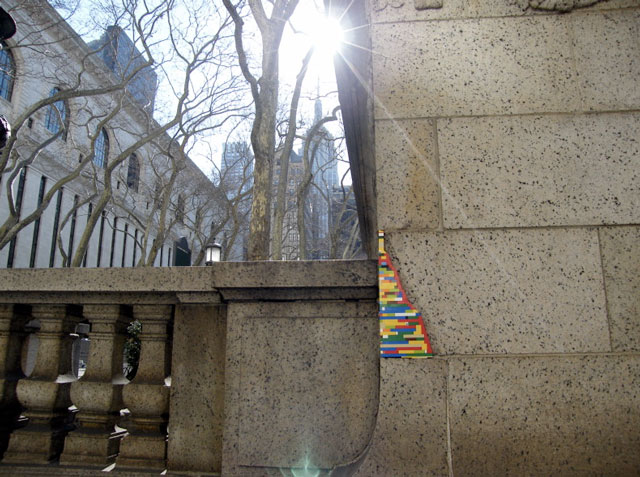Community: A Composite Construction [#CuriousCoLab]
This post is the first of hopefully many as a participant in the “Collaborative Curiosity: Designing Community-Engaged Research” online connective learning course sponsored by the Division of Community Engagement at VCU. (I will affix the same category—CuriousCoLab—to subsequent posts for the course. The #CuriousCoLab tag is also being used in Twitter conversations among participants.)

“Jan Vormann travels the world repairing crumbling monuments with Lego,” Lego fills up the cracks in the walls of Yaffo in Tel Aviv, Israel, during 2008, telegraph.co.uk
When I came across the fascinating documentation of “Lego infills” done by Jan Vormann, I didn’t immediately see these images as a representation of community. I remembered them, though, when trying to come up with a visual metaphor for the term, knowing that I wanted to emphasize community as a construction. It may be tempting to think of the way we organize ourselves as the result of a natural, organic process. But community is as much something that we consciously build in order to satisfy mutual needs (here I mean the walls to be associated with shelter and structure, not segregation).
The Lego infills illustrate that what we collectively construct we often need to repair. These plastic bricks are crude yet creative and colorful ways of completing intentions that suffered some loss along the way. So often we know what sustaining structures we want in place but struggle to maintain that unity. (The tiny plastic bricks, as opposed to uniform brick and mortar, appear more adept at filling the gaps that might develop over time. Both are necessary and reinforce one another.)
Significantly, these Lego infills don’t restore an original but instead preserve historical traces and mark the present conversing with the past. I believe it’s important to recognize the additions to existing and previous community structures to understand what is possible in the future. Communities aren’t seamless, so why not acknowledge their composite nature?

I think these are fascinating images that you have posted (I never guessed those were Legos from just looking at the pictures. I thought it was glass tile. Legos are amazing!) and I can see how they are a representation for what you say–and I agree with a lot of what you say. Thinking about it from a community engagement perspective, what struck me though is the idea that an outsider would presume to fill in or “improve” what he saw as gaps or disrepair–not invited to help make change as a partner, but deciding his own ideas and vision would be valued or appreciated, let alone helpful, and that he had the right to change the community to his liking. I think as potential community partners we can always make suggestions and share our ideas when we hope to engage communities, but we must also be very cautious that we aren’t communicating any “I know better” messages or imposing our ideas on the community. The other issue the images make me think about is how lasting those impacts will be. If people don’t remove the Legos, it won’t take long for them to become brittle or be jarred or for other reasons fall out. So the installation is, I’m sure, expected to be temporary. I think as we engage communities we have an obligation to think about whether we are going to be working towards permanent, sustainable change–or if we also are really only leaving temporary installations and what the consequences of that would be.
Thanks for the comment, Michael. You describe two considerations essential to building strong community partnerships. I found this Creative Make activity very powerful and want to replicate it in my service-learning classroom. I would definitely want undergraduates to be mindful of seeing community collaboration as a true partnership geared towards lasting change.